Online Fitness Training & Movement Rehab by a Qualified Physiotherapist & Personal Trainer.
DO YOU GET LOW BACK PAIN WITH DEADLIFTS OR KETTLEBELL SWINGS?
Perhaps you are compromising your back as a result of poor hip movement...
Studies done on low back pain show that the pain is often caused by losing the ability to move through the hips. I see this all the time in clients and always have to re-pattern their hip movement to save their backs!
Dr Stuart McGill strikes again: “This is why the hip hinge is known to be a superior movement pattern for low back pain clients. Learning to hip hinge is paramount for both injury prevention and optimal performance.”
Too right Stuart!
Learn how to move before you learn how to be strong!
If you'd like to learn how to hip hinge correctly, check this out.
If you feel like you need to work on your hip mobility then follow one of our hip mobility videos here.
Don't sacrifice your lower back for Deadlifts or Kettlebell Swings unless the movement has been broken down and taught to you effectively and you can carry it out extremely well.
CORE EXERCISE #4: CRAWLING
4th and final core exercise in our top 4...
CRAWLING:
If you are a client of mine you probably just felt a shudder down your spine...the beloved crawling pattern. You either love it or you hate it!
I personally love it as it is an awesome drill for:
- cross-patterning
- co-ordination
- core stability
- core function
- connecting left & right brain
- getting back to basics
- having fun
- mental stimulation
It also follows on nicely from the previous mentioned BIRD DOG drill, the crawling precursor.
The video demonstrates the basic crawling pattern, there are many other versions of crawling. It is a challenge to fight gravity and this is required of us on a daily basis, so why not try this cheeky little drill yourself and see what you think...feel free to comment below and share your thoughts or experiences.
THE IMPORTANCE OF GOING BAREFOOT
How often do you take your shoes off just to feel the grass between your toes, walk around the house barefoot because you can? My guess is probably not often enough ...
Your feet are incredibly important and were designed to be mobile, otherwise you wouldn't have 26 bones in such a small body part. But feet that sit in shoes all day long (particularly high heels, steel-capped boots or any heavy, high-ankle or thick-soled shoe) are not happy feet. They need to breathe and have the freedom of movement.
Because of the amount of nerve endings found in the feet (more per square centimetre than any other part of the body) , they're your gateway to proprioception (awareness of where your body is in relation to space). So imagine if your feet were stuck in thick-soled, flat shoes all day, not knowing if there was a need to alter your movement due to uneven ground, inclines, declines or changes in temperature. These are all important messages that should be received through your feet, but when they're constricted within shoes, the brain doesn't receive the feedback.
Stiffness in your feet can eventually affect muscles and joints higher up in the kinetic chain, like ankles, knees, hips and spine. Paying attention to and exercising your feet can change pain experiences in other areas of your body...never underestimate the importance of happy, healthy feet! Here are three things you can do to reclaim your feet.
1. Mobilise your feet.
Using a tennis ball, golf ball or a posture pro (as seen in picture), gently apply pressure to the bottom of the foot and roll back and forth along the whole arch, targeting any areas of tenderness. This can be done in sitting or standing. Spend at least one minute working on each foot, if not longer.
2. Get your feet moving.
Though they seem simple, these foot mobility exercises can make a huge difference. Try any of the following:
Spread your toes apart, then squeeze them together.
Point your toes, then flex.
Point your foot up from the ankle, lift it up a few inches and move it side to side, making small circles with your foot one way, and then the other.
If your feet and toes are really stiff and you struggle to connect with them, use your fingers between your toes to help get your feet moving!
3. Take your shoes off.
Spend as much time as you can barefoot. Walking your dog in the park, doing chores around the house, train barefoot in the gym...anything that re-connects your foot with the ground.
Try it! Your feet will thank you. You'll gain more mobility, stability and, if you're someone who suffers from repeated ankle sprains, you'll definitely benefit from a barefoot lifestyle as your ankles are clearly trying to tell you something!
NOW LET ME SEE YOUR HIPS SWING
THE POSTERIOR OBLIQUE SLING...CONTROLLING ROTATIONAL FORCES
REGRESS TO PROGRESS
To quote Pat Flynn from Chronicles of Strength (love this simple, yet effective way of summing up this whole blog post in 3 small symbols)...
"- = +" :-)
The golden rule in movement: REGRESS TO PROGRESS!...
For the trainers out there: please don’t expect your client to “get” movement by handing them a weight they’re not ready for and just expecting them to move correctly by shouting out a few cues to them…it ain’t gonna happen!
The only thing that happens is they learn bad movement and possibly land up with an injury.
For the fitness enthusiasts out there: you have to break down movement and work on the weaknesses within a movement pattern in order to progress a movement. Don't just think that practising single leg squats or pistols is going to get you better at doing pistols...it's only gonna get you injured. There is a reason why you struggle with certain movements, you need to find that reason and work on it! Maybe your ankles aren't mobile enough; maybe your hips are unstable; maybe you lack good sequencing in your inner unit (core); maybe you have flexility issues in either certain muscles or joints; maybe fear is holding you back; maybe all of the above! :-o There are a number of possible, likely reasons but you need to find yours.
Just because your mate did loads of hamstring flexibility and went from finding pistols difficult to being able to achieve them, doesn't mean that's going to work for you. We're all individuals here and you need to treat yourself as one. And holding a kettlebell out in front of you is not the answer, yeah, you might feel more stable but maybe, just maybe that is because you have core issues and the kettlebell is forcing your body to react to the weight by engaging your core before you descend, but what happens when you try again without the kettlebell?
I'd suggest ditching the kettlebell and stepping away from the pistol for a while to work on core sequencing...once you've made progression there, find ways to progress. I'm just using pistols as an example, this applies to anything in life. And it takes time, you're not gonna fix things overnight.
So please, think before you cause yourself harm. If I gave you one Golden Rule of advice it would be CHECK YOUR BREATHING! This is highly important for any form of stability work. If your'e unsure, my stability exercise page has a great description of how to check your breathing and how to correct it, I have video links on Youtube to help as well & my facebook page has a link to an awesome interview with Dr Perry Nickleston & Julie Wiebe on the pelvic floor & breathing...Check it out! Core function begins with breathing!
I repeat: Regress to progress…Perfection before load…Get assessed if you're unsure...
PREVIOUS INJURY IS A BIG PLAYER IN THE MOVEMENT GAME!
One of my clients, who is a keen diver, tells me whenever he swims or dives he usually always gets pretty bad cramping in his right hamstring towards the end of the swim/dive and wandered if there was anything he could do for it.
After a couple of minutes of assessment I had discovered he had a hamstring to quad dysfunction & his hamstrings were compensating for his medial quadricep (Vastus Medialis) predominantly. His VMO muscle (Oblique fibres of the Vastus Medialis that form the teardrop muscle at the knee) was particularly weak and had some noticeable wasting. His quadriceps in general on the Right side were slightly wasted in comparison to the Left.
He then precedes to tell me when he was 15 years old (+-50 years ago) he tore his medial quad & never got treatment on it, there was a noticeable dip in the muscle bulk as well which had been there ever since (a give away for a full tear or a possible partial tear). EUREKA!
So our findings related back to an ancient injury from decades ago that has manifested as dysfunction in his right side and causing him problems at this time. He admitted never having issues after the injury healed and kept playing footy for years.
Moral of the story, even though his injury was decades old and he'd adapted to it in a way that enabled him to get away without too much trouble for many years, it eventually comes back to bite you in the ass! Some cases being worse than others but don't ride on dysfunction for too long as it will always win! Post injury compensations stay with you for life, unless of course, you seek help to change them!
MOVEMENT...WHAT IT REALLY MEANS!
American Turner Gymnasium 1860
An online lecture I saw recently given by Dr Ed Thomas, an expert in the foundation of Physical Education, drove me to analyse what fitness is today in comparison to what it was historically. Historically, there are three fundamentals of movement and fitness, these are Progression, Variety & Precision.
Now from what I can tell and have observed over the years is that the majority of fitness enthusiasts seem to do well to take care of the Variety aspect of fitness, it's not hard to keep workouts varied. Progression seems to be mostly adhered to, it's quite simple, you learn a movement to a satisfactory level until it becomes quite comfortable and then you progress that movement, either by adding weight, increasing reps or challenging the movement to a higher level of difficulty (i.e. advancing from a squat to a single leg squat progression). Now, I have to take a pause here, although progression seems to be quite evident in most fitness programmes, there is a little issue that is quite niggling…this would be the over-eagerness to progress. This is a huge issue that is present within our field, you may have someone who is recently able to squat their own bodyweight comfortably but then wants to throw 40kgs onto their back and continue to squat, or a personal trainer who wants to make a client sweat more by handing them heavier weights resulting in a less precise movement pattern. You can't expect the body to move as efficiently with extra load in a movement pattern that is newly learned with only bodyweight or that is challenging enough with the current weight used. This brings me to the third and final (and I personally believe the most important) fundamental...Precision.
We need to find a way back to basics and get the population moving well and precisely again, we are so far away from our own mind-body connection that most people just go through the motions of exercise without ever making a conscious connection to how they are moving, why they are moving or how they are breathing. There was no sloppiness in movement back in the 1800's & most of the 1900's, precision was the key focus and the fitness just followed.
In Gray Cook's book, "Movement", he talks about the origins of Martial Arts and sums up what fitness should and used to be. Somehow recent generations have managed to distort this approach and turn it on it's back. Current jobs and lifestyles have a huge role to play and make it hard for the body to hold onto fundamental physical fitness, but not impossible by far! "Purposeful movement perfection was the focus, and physical conditioning happened as a natural side effect".
Modern day gyms are stacked full of equipment promoting dysfunctional movement. The use of fixed machines encourage your body not to utilise it's core stabilising musculature and instead, rely on your large, global muscles for movement. In our daily lives we need to be able to squat, lunge, push, pull, reach, run, bend and rotate, all done whilst fighting gravity (not sitting locked into a machine). This is when our bodies are moving as intended. These are the movements we need to perfect and do with precision in order to be healthy, fit individuals avoiding injury.
Look at gyms from ancient times and see if you can spot a hamstring curl, a pec deck or a leg extension machine anywhere? They only use anti-gravity equipment in the form of ropes, rings, parallel bars, ladders etc and hand weights in the shape of dumbbells, kettle bells, medicine balls and clubs.
Train functional movement patterns and make sure you do it with Precision, Variety & Progression in order to achieve true fitness. Don't rush into a new movement before you have perfected its predecessor and don't load up a movement pattern before being comfortable and strong enough in doing it body weighted first.
NO EXCUSES NOT TO SQUAT
Determination and a positive attitude go a long way in life!
Julia is one of our longest-standing clients. Squats were always a tough movement for her. When she first started training with us we did them up against the wall with her back on a fitball. Due to her Right-sided Cerebral Palsy, her Right heel would always lift off the ground as she lowered into a squat. Her squat depth was usually only to 90 degrees (hips level with knees).
Slowly, we have progressed to the rings for support and worked more on depth, now Julia is able to do deep squats using the "TRX" and her heel no longer lifts up. Movement at the Right ankle is much freer and her hips allow her to lower deeper into the squat!
Any movement you may be struggling with now, can get easier with time. You just have to stick at it and put in the hard yards!











